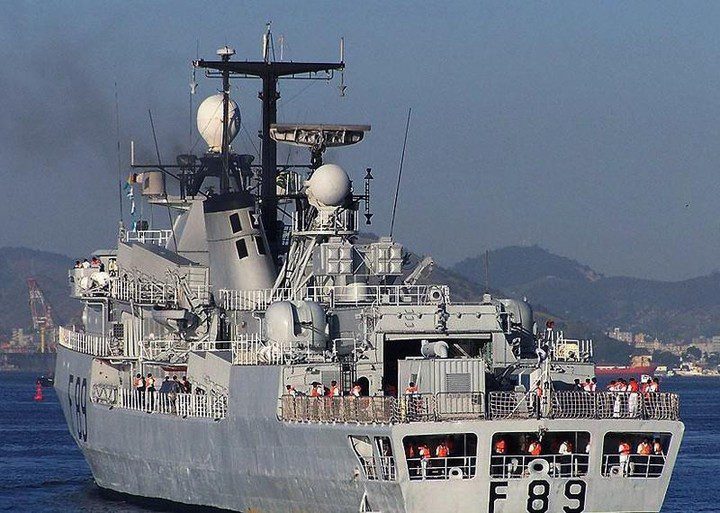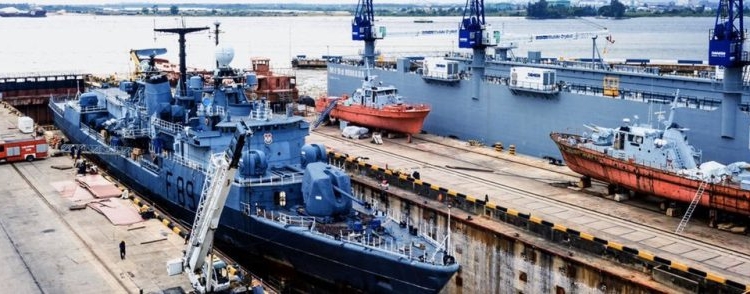Additional information regarding the modernization of Nigerian navy’s flagship NNS Aradu has emerged. NNS Aradu which is a Meko 360 class frigate designed by the German Blohm + Voss company of Hamburg in 1980 is to be refurbished and modernized by Turkish Dearsan Shipyard in a contract signed in may this year.
Tahir Conka, the Business Fevelopment Manager at Dearsan Shipyard at the IDEF 2023 defence exhibition in Turkey ccommented on the planned modernization project for the nigerian navy’s flagship NNS aradu.
In May this year, it was revealed during the Presidential Fleet Review 2023, that the NNS Aradu will be taken to Istanbul, Turkey for refit and returned within 24 months.
Tahir Conka revealed recently at the IDEF 2023 that the NNS Aradu’s navigation, communications, sensors, and electro-optical suite will be modernized. While the combat system will be partially replaced. Also the 40 mm guns will be replaced with a newer more modern variant. The ship’s hull which was scanned by Dearsan and found to be defective due to age will be strenghtened.

The Meko 360 class frigate, NNS Aradu, has served as a flagship vessel for the Nigerian Navy for several decades, playing a crucial role in safeguarding the nation’s maritime interests and contributing to regional stability.
NNS Aradu started her life as ‘The Republic’, laid down at the Blohm Voss shipyard in Hamburg on December 1, 1978, and launched on January 25, 1980, two years later.
At her prime, NNS Aradu was capable of being armed with a wide range of armaments including anti-ship and anti-air missiles, anti-submarine torpedoes and rockets, as well as powerful naval guns.
With the age and obsolescence of her major weapons, sensors, and combat systems the ship was to undertake a new role as a combat training and offshore patrol ship.
Aradu’s main gun is an OTO Melara Compact 127 mm/L54 dual-purpose gun. It fires 31 kg projectiles at up to 40 rounds/minute, out to a maximum range of 23,130 m and an anti-aircraft ceiling of 7 000 m. Capable of engaging ships, land targets, aircraft, and even some anti-ship missiles.
For air defense, it was armed with four Breda “Twin Fast Forty” CIWS turrets, each with two Bofors 40 mm/L70 automatic cannons, with one mounted at the four corners of the ship.
Each turret fires a 2.5 kg projectile at up to 900 rounds/minute out to a maximum range of 12 500 m and an anti-aircraft ceiling of 8 700 m.
These anti-aircraft guns is capable of destroying a supersonic cruise missile at up to three kilometers.
To complement the anti-aircraft guns, an Albatross surface to air missile system was mounted in an octuple launcher atop the hangar. The Albatross SAM is a variant of the United States Raytheon RIM-7 Sea Sparrow.
To combat enemy ships, the NNS Aradu is armed with eight Otomat Mk 1 anti-ship missiles carried amidships with four situated behind the mast and forward the twin funnels and two each amidships on each side of the ship.
The Otomat Mk 1 is a short-range subsonic anti-ship missile developed by the Italian company Oto Melara jointly with Matra. It is capable of reaching around 180 kilometres at an average speed of 1,100 kilometres per hour.
It is not yet certain if new missile systems will be fitted onboard NNS Aradu. The old stock of Albatross SAM and Otomat Mk 1 anti-ship missile has since been destroyed by the Nigerian Navy due to its age.
Other equipment and weapons carried includes a 6 x 324 mm torpedoes and a depth charge rack. Both are for anti-submarine warfare. An ECM suite is fitted, with a Decca RDL-2 ESM system, and two chaff mortars. Aradu is equipped with Plessey AWS 5 air/surface search radar, Racal Decca 1226 navigation radar, Signaal STIR and WM 25 fire control radar and Atlas Elektronik hull-mounted sonar. The ship originally mounted PHS 32 sonar, but this was later replaced. The frigate mounts two chaff dispensers and Decca RDL-2 electronic support measures. The ship has a hangar and flight deck capable of operation two helicopters of the Westland Lynx Mk.89 type, but usually only carries one. The vessel has a complement of 195, including 26 officers.
For propulsion, the ship is powered by a CODOG system made up of two Rolls-Royce Olympus TM3B gas turbines rated at 50,000 shaft horsepower (37,000 kW) giving the ship a maximum speed of 30.5 knots (56.5 km/h; 35.1 mph) during use and two MTU Type V 956 TH92 diesel engines rated at 10,420 brake horsepower (7,770 kW) with a maximum speed of 18 knots (33 km/h; 21 mph) under use. The engines turn two Kamewa controllable pitch propellers and the vessel carries 440 long tons (450 t) of fuel. This gives the frigate a range of 6,500 nautical miles (12,000 km; 7,500 mi) at 15 knots (28 km/h; 17 mph), with an endurance of 90 days.
Since 2010, Aradu (Hausa for “Thunder”) has been inoperable for due to lack of funding. However, in February 2020, the frigate underwent refit at the Naval Dockyard limited in Victoria Island, Lagos. By September that year, NNS Aradu sailed again albeit under the for the first time in several years.
Dearsan has also signed a contract with nigeria to supply two offshore patrol vessels, as well as a 57-meter Tuzla patrol boat. The Nigerian Navy’s newly acquired Tuzla patrol boat built by Dearsan Shipyards in Turkey will be fitted with a more reduced armament load out to reflect it’s role as an offshore patrol vessel.
The OPVs are being constructed as part of a contract signed between Dearsan and the Nigerian Navy In August, 2021. the Nigerian Navy (NN) announced its intention to procure two new offshore patrol vessels (OPV), after it received approval from the former President Muhammadu Buhari.
Turkish DEARSAN Shipyard officially started the construction of two OPV-76 Offshore Patrol Vessels for the Nigerian Navy with a keel laying ceremony held on September 16, 2022. OPV-76 ships will be fitted with four MAN product diesel engines (18VP185), and it is stated that the vessels can reach a maximum speed of 28 knots. Constructed in line with the Türk Loydu Ship Classification rules, the hulls of OPV-76s will be made of steel sheets, and marine aluminium (Sealium) will be used in the ship superstructure. The operational range of the ships is stated as 2.500nm (nautical miles). A contract was signed with HeliPLAT Co.Ltd. for the certification engineering, testing, and HAT/SAT activities of the helicopter platform on the OPV-76 ships.
The two new Turkish-built OPV 76 will further enhance Nigeria’s naval capacity currently served by two P-18N OPVS, two Hamilton-class patrol cutters, a number of fast patrol missile-boats, and several inshore patrol vessels.
They will be used for maritime interdiction operations, surveillance and special forces operations as well as providing naval fire support to land forces. “The OPVs will also be capable of conducting search and rescue operations, anti-piracy, anti-smuggling and anti-drug trafficking operations and disaster relief operations among others,” former Chief of Naval Staff Admiral Gambo said.
The Nigerian Navy continues to follow its its multi-year fleet renewal strategic plan which was formulated in 2009, and is outlined thus; short, medium, and long term.
In the short-term two light frigates, two 85 meter OPVs, six 17 meter Manta Class IPCs, two 38 meter FPBs, six Shaldag MK 11 patrol crafts two combat Augusta A138 helicopters, one Landing Platform Dock, and two Logistics Ships.
While the medium-term spanning two-five years would require ten OPVs, 20 helicopters, one hydrographic ship, two training ships, two logistics ships, and two mine countermeasure vessels (MCMVs).
In the long term spanning between five to ten years, the Nigerian Navy will require three Conventional Submarines, two corvettes, two LPDs, 20 long-range maritime patrol helicopters, two training ships, and two MCMVs.
Recent NN acquisitions includes NNS LANA, a 35m Hydrographic Survey Ship, construction work is ongoing for a LST-100 landing ship tank.
Nigeria has also indicated interest in procuring a general-purpose frigate to replace the former naval flagship Nigerian Navy Ship NNS ARADU.






